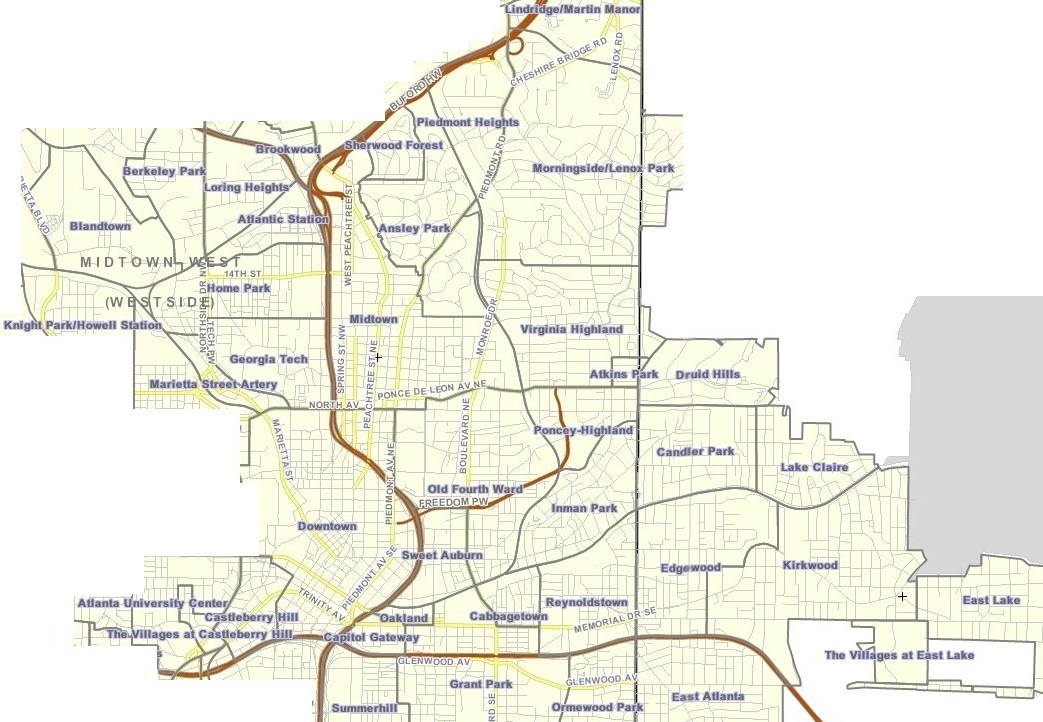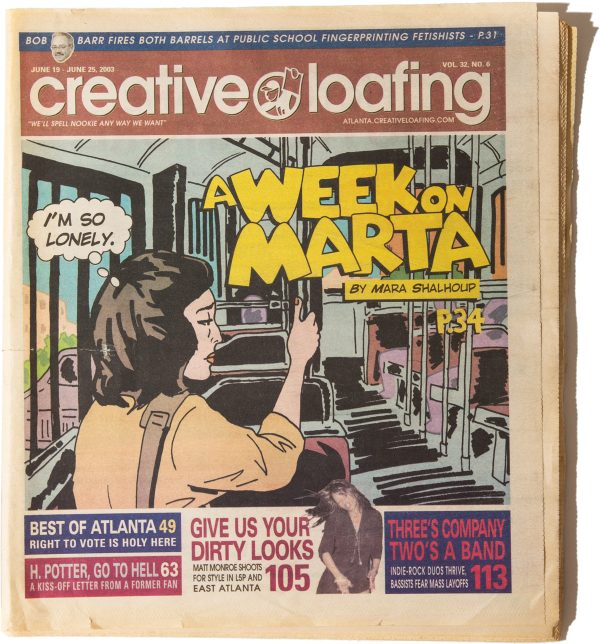|
Westside, Atlanta
Westside in Atlanta may mean: * West Midtown an arts, design, and residential district on the west side of the city, or * the entire west side of Atlanta (southwest Atlanta, northwest Atlanta) * Historic Westside Village, a mixed-use development in Vine City, northwest Atlanta "Westside" can also mean the entire west side of Atlanta. The name West Midtown is used by the neighbors' association in Home Park, the largest constituent neighborhood, and by the West Midtown Business Association. "Westside" referring to West Midtown only, is used by ''Not for Tourists'' and Westside Provisions, a privately run commercial district. However, "Westside" meaning other areas in the west side of Atlanta, or the entire west side (southwest Atlanta, northwest Atlanta), is used by the BeltLine and by Invest Atlanta, the City of Atlanta Economic Development Authority. Both "West Midtown" and "Westside" are used by ''Creative Loafing Creative Loafing is an Atlanta-based publisher of a mon ... [...More Info...] [...Related Items...] OR: [Wikipedia] [Google] [Baidu] |
West Midtown
West Midtown, also known as Westside, is a colloquial area, comprising many historical neighborhoods located in Atlanta, Georgia. Once largely industrial, West Midtown is now the location of urban lofts, art galleries, live music venues, retail and restaurants. Nomenclature West Midtown is directly west of Midtown Atlanta, hence that name. However, the name for the area is a matter of debate. The name "West Midtown" is used by the neighbors' association in Home Park, the largest constituent neighborhood, the West Midtown Business Association, and Westside Provisions, a privately run commercial district. The Atlanta Convention & Visitors Bureau uses West Midtown and defines the Westside as consisting of West Midtown and Atlantic Station. Only "Westside" or "The Westside" is used by the ''Not for Tourists'' guide. ''Creative Loafing'' has used both "West Midtown" and "Westside", but now uses "Westside" in its official neighborhood guide. The West Midtown Design District uses bo ... [...More Info...] [...Related Items...] OR: [Wikipedia] [Google] [Baidu] |
Neighborhoods In Atlanta
: The city of Atlanta, Georgia is made up of 243 neighborhoods officially defined by the city. These neighborhoods are a mix of traditional neighborhoods, subdivisions, or groups of subdivisions. The neighborhoods are grouped by the city planning department into 25 neighborhood planning units (NPUs). These NPUs are "citizen advisory councils that make recommendations to the Mayor and City Council on zoning, land use, and other planning issues". There are also a variety of other widely recognized named areas within the city; some are officially designated, while others are more informal. Other areas In addition to the officially designated neighborhoods, many other named areas exist. Several larger areas, consisting of multiple neighborhoods, are not formally defined but commonly used. Most notable are Buckhead, Midtown, and Downtown. However, other smaller examples exist, such as Little Five Points, which encompasses parts of three neighborhoods. Some of these regions may over ... [...More Info...] [...Related Items...] OR: [Wikipedia] [Google] [Baidu] |
Historic Westside Village
"'Historic Westside Village"' is a mixed-use development in Vine City, Atlanta including a Walmart, other retail stores, and apartment complexes. History In 1999, the Atlanta Housing Authority first announced plans for the "Historic Westside Village", a $130 million commercial, residential and retail project at the area's southern end near Martin Luther King, Jr. Dr. at Ashby St. Publix failure A Publix supermarket opened in May 2002 but the overall project stalled by 2003 as further anchor tenants did not materialize. This, along with disappointing sales, caused the Publix - the only full-sized supermarket for miles around - to close in December 2009. ''Creative Loafing'' called the project the most notorious "municipal boondoggle...to have tarred Atlanta" during mayor Bill Campbell's era; the project "fell victim to...cronyism, bureaucratic incompetence and a flagrant disregard for federal lending guidelines". Walmart success In December 2010 things looked up as thAtlanta Deve ... [...More Info...] [...Related Items...] OR: [Wikipedia] [Google] [Baidu] |
Mixed-use Development
Mixed-use is a kind of urban development, urban design, urban planning and/or a zoning type that blends multiple uses, such as residential, commercial, cultural, institutional, or entertainment, into one space, where those functions are to some degree physically and functionally integrated, and that provides pedestrian connections. Mixed-use development may be applied to a single building, a block or neighborhood, or in zoning policy across an entire city or other administrative unit. These projects may be completed by a private developer, (quasi-) governmental agency, or a combination thereof. A mixed-use development may be a new construction, reuse of an existing building or brownfield site, or a combination. Use in North America vs. Europe Traditionally, human settlements have developed in mixed-use patterns. However, with industrialization, governmental zoning regulations were introduced to separate different functions, such as manufacturing, from residential areas. Public ... [...More Info...] [...Related Items...] OR: [Wikipedia] [Google] [Baidu] |
Vine City
English Avenue and Vine City are two adjacent and closely linked neighborhoods of Atlanta, Georgia. Together the neighborhoods make up neighborhood planning unit L. The two neighborhoods are frequently cited together in reference to shared problems and to shared redevelopment schemes and revitalization plans."grants to the Vine City and English Avenue communities" i/ref>"The Vine City and English Avenue neighborhoods have voiced their support" iSunset Avenue Historic District English Avenue is bounded by the railroad line and the Marietta Street Artery neighborhood to the northeast, Northside Drive, the North Avenue railyards and downtown Atlanta to the east, Joseph E. Lowery Blvd. (formerly Ashby St.) and the Bankhead neighborhood to the west, and Joseph E. Boone Blvd. (called Simpson St. until 2008) and Vine City to the south. Its population was 3,309 in 2010.2010 U.S. census figures as tabulated bWalkScore/ref> Vine City is bounded by Joseph E. Boone Blvd. (Simpson) ... [...More Info...] [...Related Items...] OR: [Wikipedia] [Google] [Baidu] |
Home Park, Atlanta
Home Park is a neighborhood of Atlanta in Georgia, US. It is bordered on the south by Georgia Tech, on the west by the railroad yards adjacent to Marietta Street and Brady Avenue, on the north by 16th Street aAtlantic Station and on the east by Techwood Drive at I- 75/ 85 (the Downtown Connector). The neighborhood is known as West Midtown Atlanta since it lies on the west side of the Downtown Connector. The residential district is bordered by Northside Drive, Techwood Drive, 10th Street, and 16th Street. This section is also home to the media organizations CBS Atlanta WGCL-TV, Georgia Public Broadcasting and Turner Broadcasting System, Inc. The commercial district is west of Northside Drive over to Marietta Street and Brady Avenue. It has retail and services, design firms, art galleries, restaurants and an expanding residential section along Howell Mill Road. History Home Park was developed in 1901 as housing for workers at the Atlantic Steel Mill located where Atlantic Statio ... [...More Info...] [...Related Items...] OR: [Wikipedia] [Google] [Baidu] |
Westside Provisions
Westside Provisions is a mixed use neighborhood located in the West Midtown area of Atlanta, Georgia, United States. History Westside Provisions was formed in 2008 by the construction of a footbridge linking the Westside Urban Market to White Provision. White Provision occupies the White Provision Co. building, constructed in 1910 and expanded in 1922–1924 in the Industrial Gothic style. It served as a meat packing plant and was sold to Swift and Company. In 1963 the property was converted into a bonded warehouse and in 1991 as a U-Haul storage center and as residential lofts. Westside Urban Market is built on the site of the 1917 United Butchers Abattoir, later the site of Stovall and Co. Both the abattoir and meat packing facility were established in proximity to the Miller Union Stockyards then located in the area from the 1880s through 1940s. Neighborhood features Westside Provisions includes dining and national retailers. For retail, the development is anchored by a la ... [...More Info...] [...Related Items...] OR: [Wikipedia] [Google] [Baidu] |
BeltLine
The Atlanta BeltLine (also Beltline or Belt Line) is a open and planned loop of multi-use trail and light rail transit system on a former railway corridor around the core of Atlanta, Georgia. The Atlanta BeltLine is designed to reconnect neighborhoods and communities historically divided and marginalized by infrastructure, improve transportation, add green space, promote redevelopment, create and preserve affordable housing, and showcase arts and culture. The project is in varying stages of development, with several mainline and spur trails complete and others in an unpaved, but hikeable, state. Since the passage of the More MARTA sales tax in 2016, construction of the light rail streetcar system is overseen by MARTA in close partnership with Atlanta BeltLine, Inc. __TOC__ History and concept As railroad rights-of-way The first development of the BeltLine area began when the Atlanta & West Point Railroad began building a connecting rail line from its northern terminus ... [...More Info...] [...Related Items...] OR: [Wikipedia] [Google] [Baidu] |
Creative Loafing
Creative Loafing is an Atlanta-based publisher of a monthly arts and culture newspaper/magazine. The company publishes a 60,000 circulation monthly publication which is distributed to in-town locations and neighborhoods on the first Thursday of each month. The company has historically been a part of the alternative weekly newspapers association in the United States. Creative Loafing began as a family-owned business in 1972 by Deborah and Chick Eason, expanding to other cities in the Southern United States in the late 1980s and 1990s. In 2007 it doubled its circulation with the purchase of the ''Chicago Reader'' and ''Washington City Paper''; the $40 million debt it incurred, along with an economic recession, forced the company into bankruptcy one year later. The parent company, Creative Loafing, Inc. was dissolved and Atalaya sold off the ''Chicago Reader''. In 2012, SouthComm purchased all of the properties and then sold off each of the papers to other publishers in 2018. The A ... [...More Info...] [...Related Items...] OR: [Wikipedia] [Google] [Baidu] |


.jpg)


